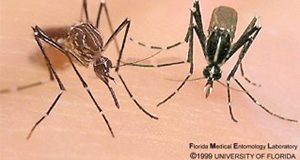
Zika is a mosquito-transmitted virus that has recently spread to the Americas. Zika virus (ZIKV) was discovered in 1946 in Africa where it was isolated from a Rhesus monkey in the Zika forest of Uganda. In 2007, a disease outbreak occurred on the Yap islands in Micronesia, and in 2013, an outbreak occurred in French Polynesia. In 2015, a large outbreak occurred in Brazil, and ZIKV has since spread through the Americas. As of April 18, 2016, 15 counties in the state of Florida had reported travel-associated Zika cases. This seven-page fact sheet provides an overview of ZIKV, including its incidence and distribution, transmission and symptoms, and the connection between zika virus and infant microcephaly. This article also explains the biology and identification of the mosquito that vectors the virus with a focus on how to manage the vector using inspection, larviciding, adulticiding, monitoring, and personal protective equipment. Written by Casey Parker, Roxanne Connelly, Dale Dubberly, Roberto Pereira, and Philip Koehler and published by the Entomology and Nematology Department.
http://edis.ifas.ufl.edu/in1131